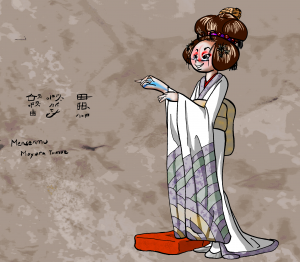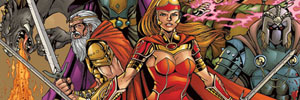Tag: nippon
#24 Moyura Tomoe
Moyura Tomoe, 12, has been an invaluble source of information of Ao Lai culture for American reporters. Between practice sessions and daily chores, she gives us information about the day-to-day lives of her people and her fellow workers as well as an insight into Ao Lai’s history. Americans are welcome in Ao Lai, but it’s almost a de facto rule in Ao Lai that the Ao Liese do not leave their soil; prices to travel to America are in the top five of the most expensive things an Ao Liese person can buy. Because of this, Tomoe has not been to the states, but she was curious about the Americans, as many Ao Liese are, and did not turn down the oppurtunity to speak with us when we offered her a special spot on our radio show, Purple Country, a television program in which guests, both Ao Liese and American, explore a topic and how its impact differs between their cultures. Tomoe was an innocent and curious but very mature girl, and her apperance was a hit in America and even more so in Ao Lai, where the show is brodcasted as a podcast. When fans clamored to see more of Tomoe, we offered her another chance when we asked her for an interview. The response was as expected, and soon, Purple Country and Ms. Moyura began to slowly, very slowly, bridge the gap between America and Ao Lai. We asked her about the nature of her work and one of the uniforms she had, and she told us:
“The Mensenjaji… of Ao Lai’s Nippon are the women and girls in the art called Mensenyokaji, the female profession of communing with Ao Liese spirits. Ao Liese people believe women are more in tune with the spirit world because we are healthy and feel many more emotions than men. They are in touch with the mytical creatures. Mensenmu is my rank. I perform the ceremonial dances that are accompanied by music or by singing or both. My makeup… is meant to symbolize or represent the face of the spirit of… merciful death, Huang Mu… The red paint enhances the features and imitates the folds on Huang Mu’s face. The blue makeup highlight/imitate the loss or stagnation of blood in certain areas. The whitish makeup… represents the pallid complexion of those that are ill, dying, or dead. My outfit is not a furisode. It is called a “non,” which is Harayin for “long.” My sleeves are very long, because I have items I use in my dances in my sleeves. I need room to pull them out gracefully. The colors are the ones… the Mighty Huang Mu… is often seen wearing, so… I wear that. The flowers and leaves in my hair mostly represent beauty… I wear 12 pins in my hair, because 12 is a symbol of womanhood, and Huang Mu… prefers to interact with woman instead of with girls.”










#30Characters Chatter…